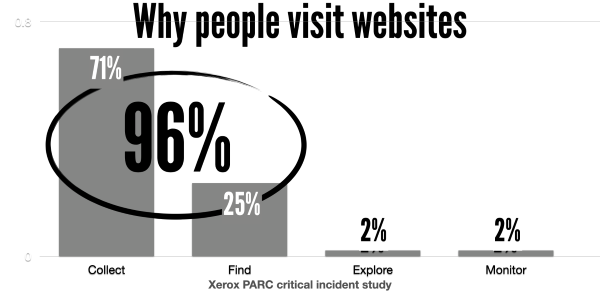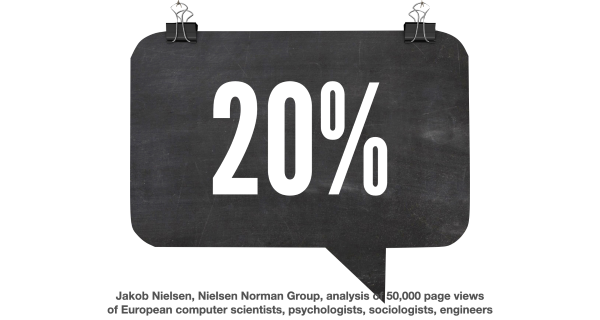They don’t; so make webpages scannable
Here’s the title of one of usability expert Jakob Nielsen’s earliest articles on writing for the web:

How Users Read on the Web
The first paragraph:
They don’t.
“People read paper,” says TJ Larkin, principal of Larkin Communications Consulting. “They use the web.”
Screen reading is different from print materials. In fact, people read word-by-word online just 16% of the time, according to eye-tracking studies by Dejan Marketing. That’s the same percentage Nielsen came up with in his eye-tracking research.
So if they’re not reading, what are they doing?
They’re not reading; they’re seeking.
Web users spend most of their time looking for something specific. According to research findings by Xerox PARC, web visitors:
- Collect 71% of the time. They search for multiple pieces of important information, maybe research for a Writing for Mobile workshop.
- Find 25%. They seek something specific, like “What is this bacalhau they want to serve me for lunch?”
- Explore 2%. They look around without a specific goal — aka “surfing.”
- Monitor 2%. They return to the same website to update information — say, checking CNN for the latest news.

In other words, web visitors have a goal 96% of the time, according to the PARC study. So much for “surfers.”
Same thing’s true on mobile. In fact, the No. 2 mobile task is searching for specific information. (No. 1: wasting time.)
Mobile visitors often seek information relevant to the here and now, like “Where is the nearest gas station?” In fact, according to a Pew study, some 49% of mobile users use their phones for location-based information.
How long do they spend?
So as they look for information, how much time do visitors spend on webpages? Not too long:
- The average page visit lasts less than a minute — but many are 10 seconds or less.
- 55% of visitors spend fewer than 15 seconds on your website.
- Visitors spend an average of 19 seconds looking at a webpage.
During that time, according to Kara Pernice, Kathryn Whitenton and Jakob Nielsen, authors of How People Read on the Web, web visitors’ eyes land an average of 72 times on different elements on the page. (Learn more about these reading patterns, including the F-shaped pattern, where visitors’ eyes sweep across the left side of the page.)
“As you watch users’ eyes negotiate pages at mind-blowing speeds, you might think that … it is just pure luck that anyone ever finds anything worthwhile on the web.”
— Kara Pernice, Kathryn Whitenton and Jakob Nielsen, in How People Read on the Web
Let’s do that math: 19 seconds divided by 72 “eye stops” equals about a quarter of a second per glance.
Definitely. Not. Reading.
“As you watch users’ eyes negotiate pages at mind-blowing speeds,” write Pernice et al., “you might think that … it is just pure luck that anyone ever finds anything worthwhile on the web.”
How much do they read?
As web visitors’ eyes race around your webpage for 10 to 20 seconds or so, how much of your content are they actually reading?

About 20% of the words on the page, according to a Nielsen Norman Group analysis of 50,000 page views that European computer scientists, psychologists, sociologists, engineers and other highly educated professionals completed while going about their daily lives.
“What’s important about this study is that it was completely naturalistic,” Nielsen writes. “The users didn’t have to do anything special.”
Here’s what he found:
- On average, web visitors read half the information on webpages with 111 words or less.
- As the word count goes up, so too does the amount of time visitors spend on a page. But reading time doesn’t keep up with the additional word count. Web visitors spend only 4.4 seconds more for each additional 100 words. Assuming an average reading time of 200 words per minute, that’s only about 15% of the additional words.
- Web visitors spent enough time to read at most 28% of the words on a webpage during an average visit. However, Nielsen says, they don’t spend all that time reading. It’s more likely, he estimates, that visitors read only 20% of the words on the average webpage.
But which 20%?
Where are they looking?
So which words do they read? The microcontent, or online display copy.
In a study by Conversion XL, here’s where web visitors focused their attention:
- 97% read headlines. They averaged 2.9 seconds, which gave them time to read 7 words, according to the researchers.
- 98% read decks, or the one-sentence summary under the headline. They spent 2.8 seconds, or about 7 words.
- More than 90% viewed captions.
Web visitors also look at the:
- Subheads
- Links
- Bulleted lists
- Bold-faced text
And if you want to reach web visitors, that’s where you’ll put your messages.
_____
Sources: Jakob Nielsen, “How Users Read on the Web,” Nielsen Norman Group, Oct. 1, 1997
“Here’s Why Nobody Reads Your Content,” Dejan Marketing, June 11, 2015
Kathryn Whitenton, “Satisficing: Quickly Meet Users’ Main Needs,” Neilsen Norman Group, March 30, 2014
Tony Haile, CEO of Chartbeat; “What You Think You Know About the Web Is Wrong,” Time, March 9, 2014
Kara Pernice, Kathryn Whitenton and Jakob Nielsen; How People Read on the Web; Neilsen Norman Group
Jakob Nielsen, “How Little Do Users Read?” Alertbox, May 6, 2008
Harald Weinreich, Hartmut Obendorf, Eelco Herder, and Matthias Mayer; “Not Quite the Average: An Empirical Study of web use,” ACM Transactions on the web,vol. 2, no. 1, February 2008, article #5
Madeleine Sidoff, “How People Read Short Articles [Original Research],” ConversionXL.com, Jan.19, 2018

Leave a Reply